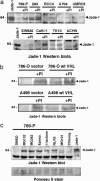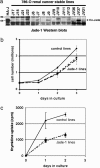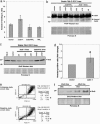Jade-1, a candidate renal tumor suppressor that promotes apoptosis
- PMID: 16046545
- PMCID: PMC1182408
- DOI: 10.1073/pnas.0500757102
Jade-1, a candidate renal tumor suppressor that promotes apoptosis
Abstract
Medical therapies are lacking for advanced renal cancer, so there is a great need to understand its pathogenesis. Most renal cancers have defects in the von Hippel-Lindau tumor suppressor pVHL. The mechanism by which pVHL protein functions in renal tumor suppression remains unclear. Jade-1 is a short-lived, kidney-enriched transcription factor that is stabilized by direct interaction with pVHL. Loss of Jade-1 stabilization by pVHL correlates with renal cancer risk, making the relationship between Jade-1 and renal cancer compelling. We report that Jade-1 expression was barely detectable in all tested renal cancer cell lines, regardless of VHL status. Strikingly, proteasome inhibitor treatment increased endogenous Jade-1 expression up to 10-fold. Jade-1 inhibited renal cancer cell growth, colony formation, and tumor formation in nude mice. Intriguingly, Jade-1 also affected the pattern of cell growth in monolayer culture and 3D culture. Jade-1 increased apoptosis by 40-50% and decreased levels of antiapoptotic Bcl-2. Antisense Jade-1-expressing cells confirmed these results. Therefore, Jade-1 may suppress renal cancer cell growth in part by increasing apoptosis. Jade-1 may represent a proapoptotic barrier to proliferation that must be overcome generally in renal cancer, perhaps initially by pVHL inactivation and subsequently by increased proteasomal activity. Therefore, Jade-1 may be a renal tumor suppressor.
Figures






References
-
- Latif, F., Tory, K., Gnarra, J., Yao, M., Duh, F. M., Orcutt, M. L., Stackhouse, T., Kuzmin, I., Modi, W., Geil, L., et al. (1993) Science 260, 1317-1320. - PubMed
-
- Maxwell, P. H., Wiesener, M. S., Chang, G. W., Clifford, S. C., Vaux, E. C., Cockman, M. E., Wykoff, C. C., Pugh, C. W., Maher, E. R. & Ratcliffe, P. J. (1999) Nature 399, 271-275. - PubMed
Publication types
MeSH terms
Substances
Grants and funding
LinkOut - more resources
Full Text Sources
Other Literature Sources
Medical
Molecular Biology Databases

